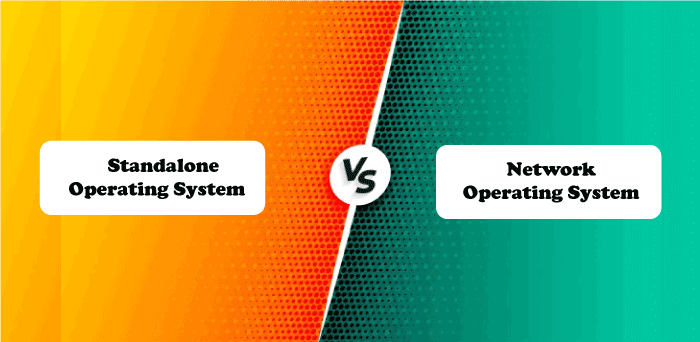Difference between Standalone and Network Operating SystemAn operating system is responsible for a computer's overall functionality. It handles various functions, including hardware device management, process and memory management, system resource security, and various other important functions. There are various kinds of operating systems. Standalone and network OS are two of them. In this article, you will learn the difference between the standalone and network operating system. But before discussing the differences, you must know about the standalone and network Operating systems. What is the standalone operating system?A standalone OS is an OS that runs on a device like a notebook, desktop computer, or laptop. A standalone operating system offers a complete functioning framework. Some examples of standalone operating systems include Mac OS, DOS, Windows 95, and Windows 2000 Professional. DOS is a single-user OS with both a CLI and a menu-driven interface. MAC OS is a GUI-based OS intended for the Macintosh series of personal computer systems. Windows 2000 Professional, Windows 7, and Windows 10 are multitasking OS with GUIs. They are intended for power users and business users. Furthermore, they are safe, secure, and stable OS. Features of Standalone Operating SystemThere are various features of the Standalone operating system. Some features of the Standalone operating system are as follows:
What is the network operating system?The network OS is an OS that operates on the server. It helps to enable the server to handle data, groups, users, and security and offers various features to the connected devices. It is sometimes known as a server operating system. The primary goal of using a network OS is to enable devices to share data and access resources like printers through a LAN, a private network, and other networks. Network OS include Microsoft Windows Server 2003, 2008, UNIX, and Linux. It makes the server more safe, secure, and stable. The network operating system implements many protocols via the network and ensures that network functionalities are properly implemented. One disadvantage of the network operating system is that it is tightly connected to the network. Integrating the latest technologies and hardware into the computer system is also simpler. However, these types of operating systems are very expensive and need constant maintenance and updating. Advantages and Disadvantages of Network Operating SystemThere are various advantages and disadvantages of a network OS. Some of the advantages and disadvantages are as follows: Advantages
Disadvantages
Key differences between the standalone and network operating system
There are various key differences between the standalone and the network operating systems. Some differences of the standalone and network operating system:
Head-to-head comparison between the standalone operating system and network operating systemThere are various head-to-head comparisons between the standalone and network operating system. Some of them are as follows:
|
 For Videos Join Our Youtube Channel: Join Now
For Videos Join Our Youtube Channel: Join Now
Feedback
- Send your Feedback to [email protected]
Help Others, Please Share









